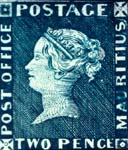
(Genuine stamp, Reduced size, note that the 'A' and 'U' of Mauritius are damaged)
Les Óles Maurice
Return To Catalogue - Types of the 1848 issue - Types of the 1859 issues - Mauritius 1847 forgeries - 1858 sitting Brittania issue - Issues of 1860-1895 - Issues of 1896-1920 - Mauritius miscellaneous
Currency: 12 pence = 1 Shilling;
20 Shillings = 1 Pound
1878: 100 Cents = 1 Rupie
Note: on my website many of the
pictures can not be seen! They are of course present in the cd's;
contact me if you want to purchase them: evert@klaseboer.com.
Many images of this page have been reproduced with permission from: http://www.sandafayre.com

(Genuine stamp, Reduced size, note that the 'A' and 'U' of
Mauritius are damaged)
1 p orange 2 p blue
These stamps are extremely rare. Of the 1 p red 2 unused specimens and 11 used specimens are known. Of the 'blue Mauritius' (the 2 p blue) only 500 stamps were printed in 1847, only 12 stamps are known to have survived upto today; 6 used (3 on letter) and 6 unused. Of the orange 1 p value 14 (15?) values have survived. The Communication Museum in the Hague posseses one of these 2 p stamps (the first picture above). The 1 p was used for local letters in Port Louis, the 2 p for letters to other places within Mauritius. It is said that the engraver of these stamps, Joseph Osmond Barnard, made a mistake when he put 'POST OFFICE' on the left side of the stamp. If this is really true, or just a nice story, I don't know. Fact is, that it is replaced by 'POST PAID' in the next serie. 500 of each value were printed. Many of them ended up on invitation letters from the wife of the governor William Maynard Gomm for a masked ball, who used them on 21st September 1847 (which is also the first time these stamps were ever used). After a few days, all the stamps were sold out. A few of the invitation letters of the wife of Gomm have survived. These two stamps are the first stamps issued by a British colony. One famous letter, the Bordeaux letter (named after the place of discovery) bears a 1 p and a 2 p. This letter was owned by famous collectors as Arthur Hind. It was sold to a Singaporean collector in 1993 for about 3.5 US$.
Value of the stamps |
|||
vc = very common c = common * = not so common ** = uncommon |
*** = very uncommon R = rare RR = very rare RRR = extremely rare |
||
| Value | Unused | Used | Remarks |
| 1 p | RRR | RRR | |
| 2 p | RRR | RRR | |
For reprints and forgeries of these
stamps click here.
More on the history of these stamps: http://www.helenmorgan.net/bm/home.html.
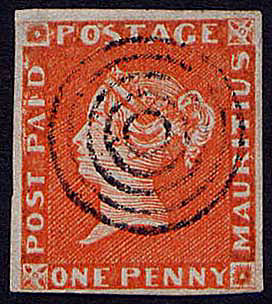
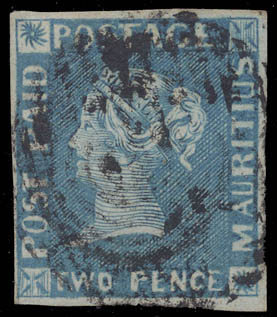
Two stamps from the Ferrari collection
1 p red 2 p blue
For the specialist, there are 12 types of each of this stamp (Click here for Mauritius Types of the 1848 issue). Specialists distinghuish between early printing and printings from worn plates.
Value of the stamps |
|||
vc = very common c = common * = not so common ** = uncommon |
*** = very uncommon R = rare RR = very rare RRR = extremely rare |
||
| Value | Unused | Used | Remarks |
| 1 p | RRR | RR | |
| 2 p | RRR | RRR | |
Misprint 'PENOE' instead of 'PENCE':
This misprint occurs in position 7 of the plate (consisting of 12 stamps: 3 x 4).
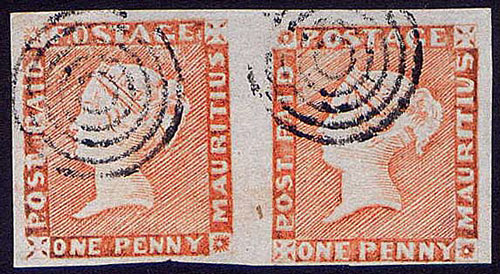
Strip of two stamps, originating from the Ferrari collection. It
was offered as item 375 in the II Ferrari auction

Strip of two stamps. Position 2-3, originating from the Ferrari
collection. It was offered as item 354 in the II Ferrari auction
According to 'Les Timbres de Maurice' by Moens, reprints of the 1 p were made by Evans in 1877. Evans also obtained some proofs in black color.
Typical cancels:
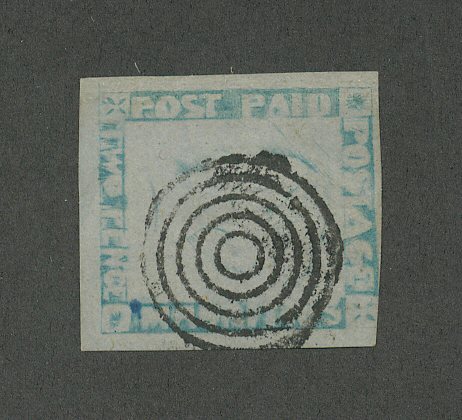
Target cancel consisting of concentric rings
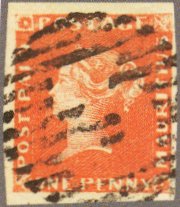
Grid cancel
Numeral cancels
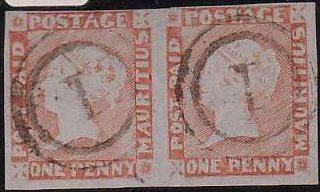
The numbers in the numeral cancel correspond to
the following 17 postoffices that opened from 1848 through 1860:
1: Mahebourg
2: Centre de Flacq
3: Pamplemousses
4: Souillac
5: Plaines Wilhelms
6: Curepipe
7: Petite Riviere
8: Ville Bague
9: Poudre d'Or
10: Gand Bay
11: Moka
12: Black River
13: Grand River S.E.
14: Riviere du Rempart
15: Plaine Magnien
16: Riviere Seche (Eastern Suburb?)
17: Mare d'Albert
In 1869 a new numbering system was introduced (with numeral
cancels surdounded by bars)
Examples:
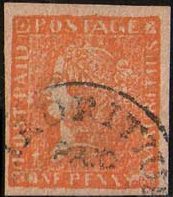
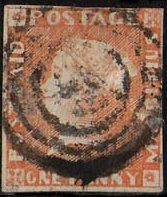
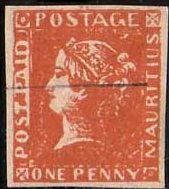
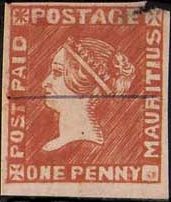
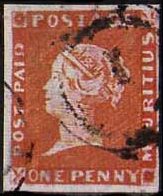
Forgeries with 'Facsimile' overprint (and subsequently removed again on the second stamp), also with '27' numeral cancel:

Block of four 1 p stamps with 'Fac-simile' overprint pretending
to be from a worn plate, note that there are several types.
More information on the 'Fac-simile' stamps can be found by clicking here.
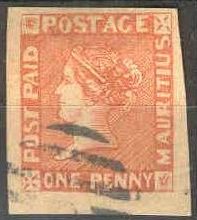
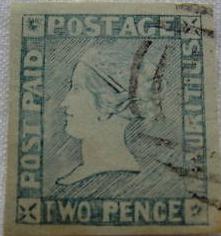
Possibly some forgeries of Italian orgin (Oneglia/Panelli?)
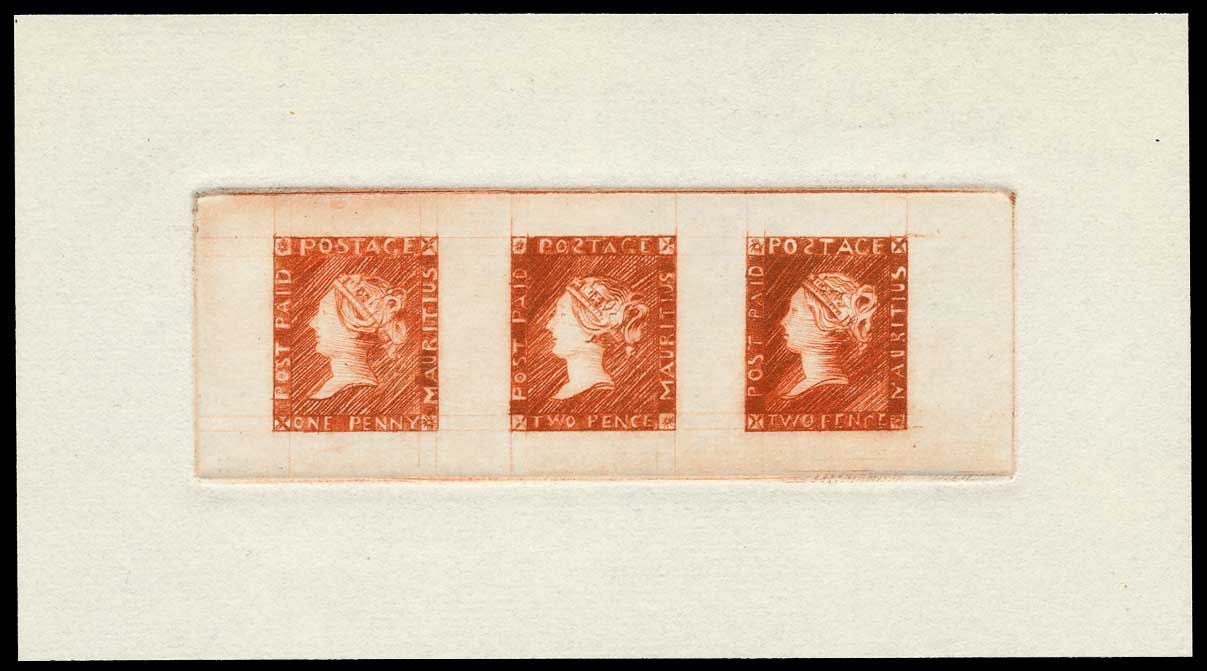
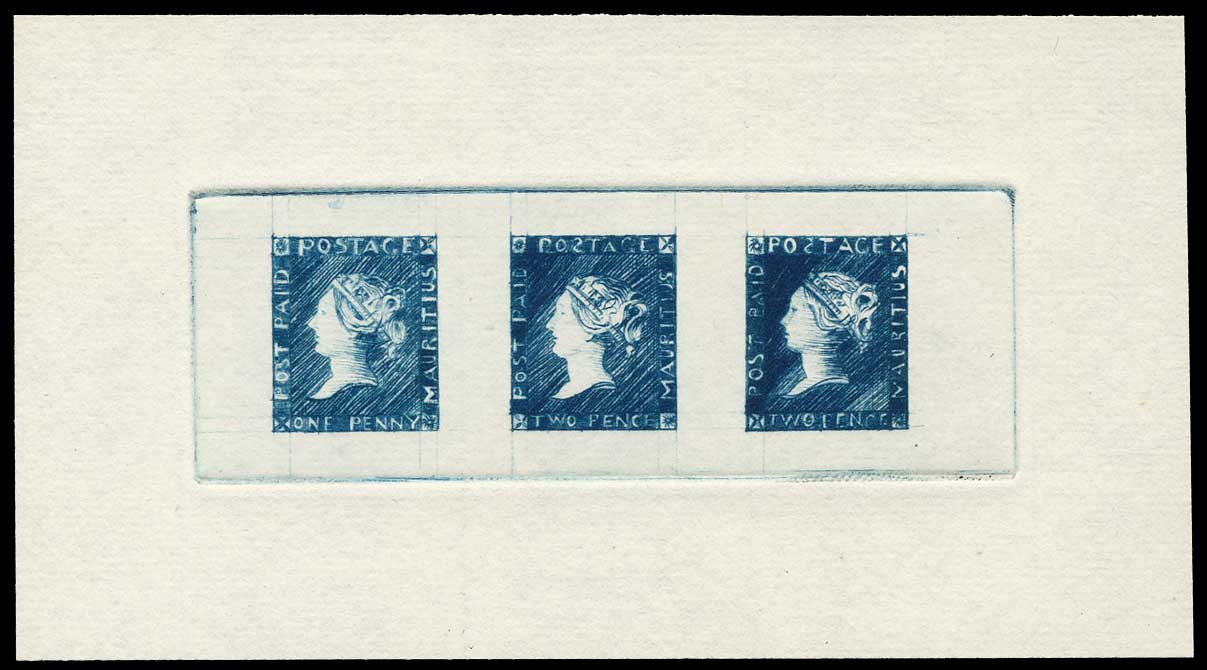
Some reprints including ones with teh "S" of
"POSTAGE" inverted.
2 p blue (12 types)
This stamp is called 'fillet head', it was a re-engraved by Sherwin from the plates of the 1848 stamps. There are 12 types of this stamp. Click here for Mauritius Types of the 1859 issues.
Value of the stamps |
|||
vc = very common c = common * = not so common ** = uncommon |
*** = very uncommon R = rare RR = very rare RRR = extremely rare |
||
| Value | Unused | Used | Remarks |
| 2 p | RRR | RRR | |
Reprints were apparently made in 1923 with the original plate. An image of such a sheet can be found under Mauritius Types of the 1848-1859 issues.
Forgeries, example:
A stamp with a 'Fac-simile' overprint and two other stamps in the wrong colour orange and red (probably made by the same forger):
More information on the 'Fac-simile' stamps can be found by clicking here
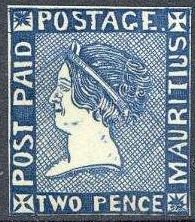
(A forgery made by Peter Winter)
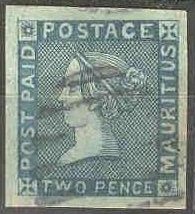
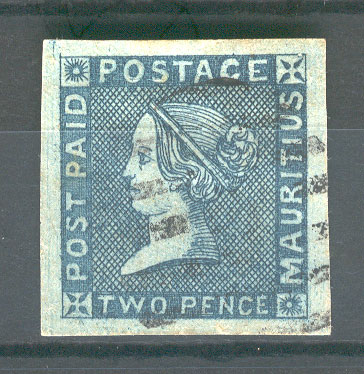
(Forgeries made by Oneglia)
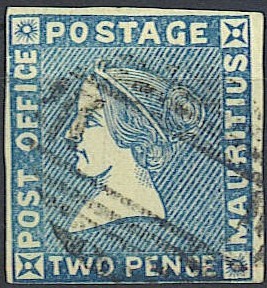
Forgery in the Sherwin design, but with 'POST OFFICE' instead of
'POST PAID', the 1 p red also exists of this forgery type.
2 p blue on blue (12 types; printed in 3 rows of 4 stamps)
Value of the stamps |
|||
vc = very common c = common * = not so common ** = uncommon |
*** = very uncommon R = rare RR = very rare RRR = extremely rare |
||
| Value | Unused | Used | Remarks |
| 2 p | RRR | RRR | |
Click here for Mauritius Types of the 1859 issues
Specialists distinguish first issues and later issues from worn plates, example:
These stamps were printed with very large spaces between the stamps (horizontally and vertically), example:
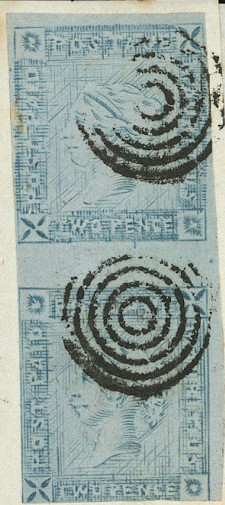
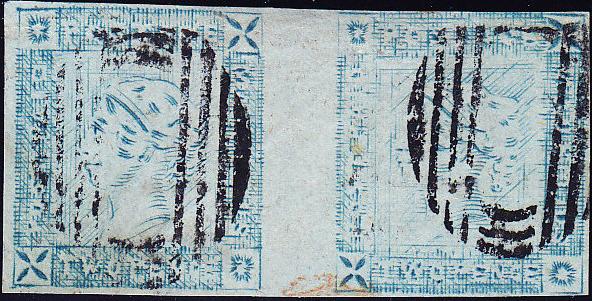
Vertical and horizontal pair with very large spacing
examples:
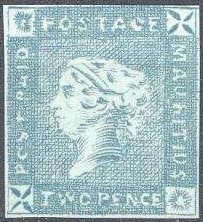
(A forgery made by Peter Winter)
I've been told that the next stamp is a reprint, but I think it is an ordinary forgery:
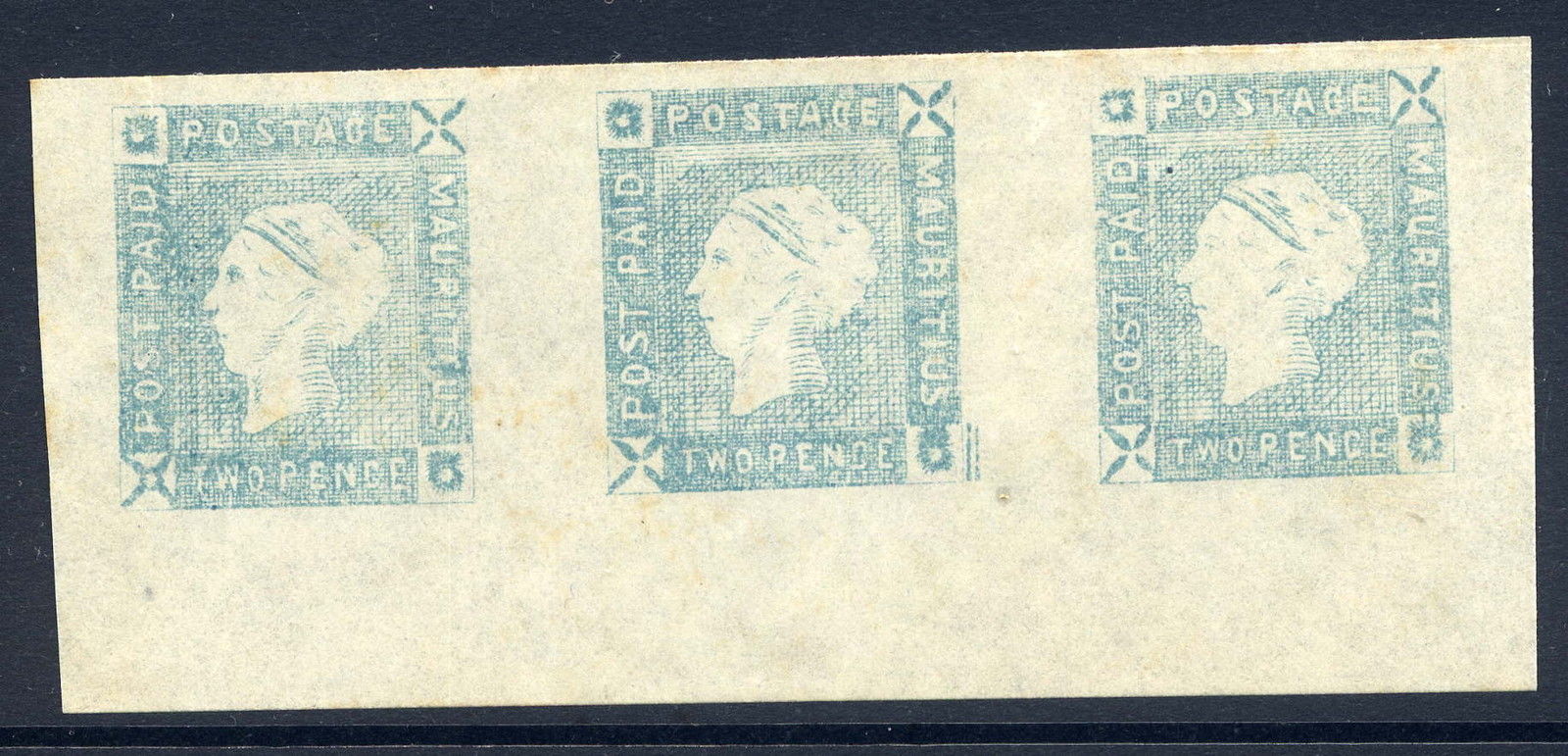
Block of three of these forgeries.
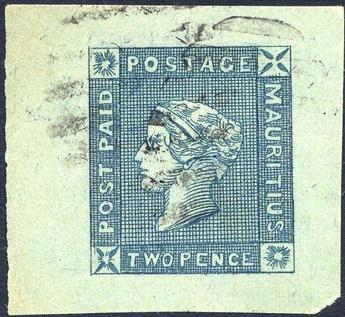
Forgery with very broad margins and the chin of the Queen is very
large. It is pretending to be position 9
on the plate (with a damaged lower left corner cross).
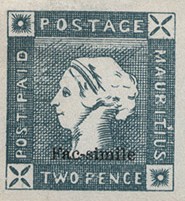
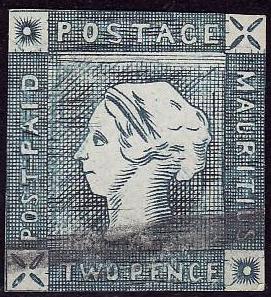
Forgery with overprint "Fac-simile". Next to it the
same forgery but with "Fac-simile" erased.
Forgeries with overpint "Fac-simile" exist. More information on the 'Fac-simile' stamps can be found by clicking here.
1 p red 2 p blue
Value of the stamps |
|||
vc = very common c = common * = not so common ** = uncommon |
*** = very uncommon R = rare RR = very rare RRR = extremely rare |
||
| Value | Unused | Used | Remarks |
| 1 p | RRR | RRR | |
| 2 p | RRR | RRR | |
A 2 p stamp, showing 'retouching' below the word 'TWO':
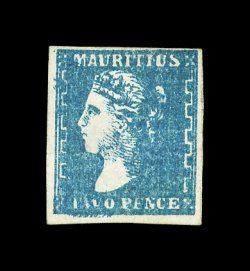
examples:

(Reduced size)
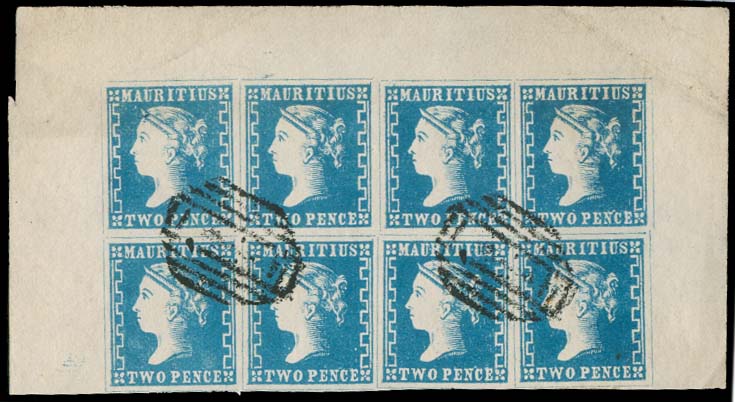
Part of a sheet with these forgeries, note the guidelines between
the stamps, which genuine stamps don't have.
The above two stamps must be second forgery of the 1 p described in Album Weeds: The 'S' of 'MAURITIUS' is like an ordinary 'S', but in the genuine stamps it is like a reversed 'Z'. There is no stop behind 'MAURITIUS', in the genuine stamps there always is a stop. In the genuine the letters of 'ONE PENNY' are smaller than the letters of 'MAURITIUS', in this forgery they all have the same size. The 'M' and the 'S' of 'MAURITIUS' are at an equal distance from the flower like ornaments in the corners. In the genuine stamp, the stop and the 'M' of 'MAURITIUS' are at an equal distance from these ornaments. There is no white dot in the flower in the left top corner (not clearly visible in the above forgeries). The 'M' of 'MAURITIUS' is always badly shaped. There are not the same number of lines in the left and right side of the stamp (the brick alike pattern). As cancels of the originals Album Weeds states the cancel we can see on the first forgery above (an empty center with 4 horizontal lines above and below and slightly curved lines vertically at both sides) or a circle with 'PAID' inside. The cancel of the second forgery (a diamond with horizontal lines across it) was never used in Mauritius and is an easy test to quickly identify this forgery in this case. I've also seen the 1 p value with a cancel consisting of 4 concentric circles. The 2 p blue forgeries are made by the same forger. I've seen the 2 p being offered on a prestigious internet auction as being genuine....
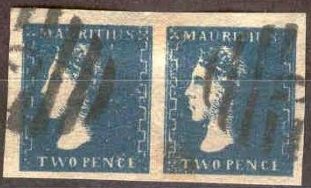
(Other forgeries of the 2 p, reduced sizes)
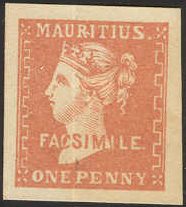
(Senf forgery, 'FACSIMILE' added in the
design)
A 'replik' forgery probably made by Peter Winter:
Click here for Mauritius 1858 sitting Brittania issue